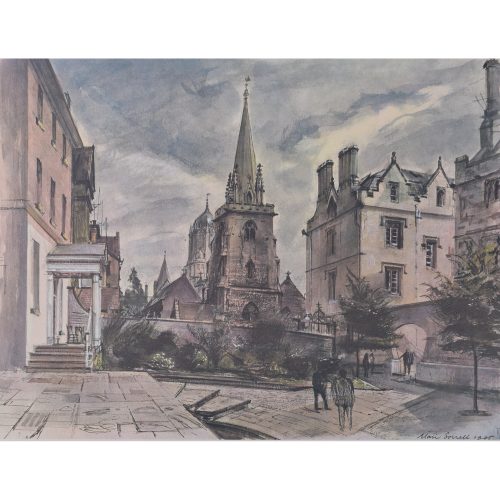-
Out of stock
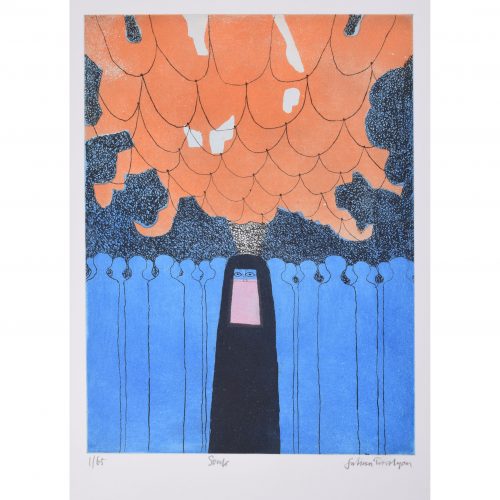
Julian Trevelyan (1910 - 1988)
Souk (1972)
Etching and aquatint 71 x 56 cm Signed, titled, and numbered 1/65 in pencil outside of the plate. The Tate Collection holds number 25/65. An Arab bazaar. Tall, nameless blue figures surround a veiled and staring woman. Nephew of the historian G M Trevelyan, Julian Trevelyan was educated at Bedales and then at Trinity College, Cambridge, where he read English. After moving to Paris, Trevelyan studied engraving at Stanley William Hayter’s school, working alongside artists such as Max Ernst, Joan Miro and Pablo Picasso. He married the potter Ursula Darwin in 1934, and in 1935 they moved to Hammersmith, buying Durham Wharf beside the River Thames which was Trevelyan’s studio – and home – for the rest of his life. His wartime service was – like so many artists – as a camoufleur. A Royal Engineer from 1940-43, he served in North Africa and Palestine, forcing the German Afrika Korps to use resources against a dummy army whilst real tanks were disguised as more harmless equipment. In the desert, nothing could be hidden - but it could be disguised. Following the dissolution of his marriage in 1950, he married the painter Mary Fedden. Teaching at Chelsea School of Art, Trevelyan eventually became head of the Etching Department and his pupils included David Hockney and Peter Ackroyd. Condition: mounted to board, small scuff to very bottom of margin, otherwise very good. If you’d like to know more, please email info@manningfineart.co.uk or call us on 07929 749056. -
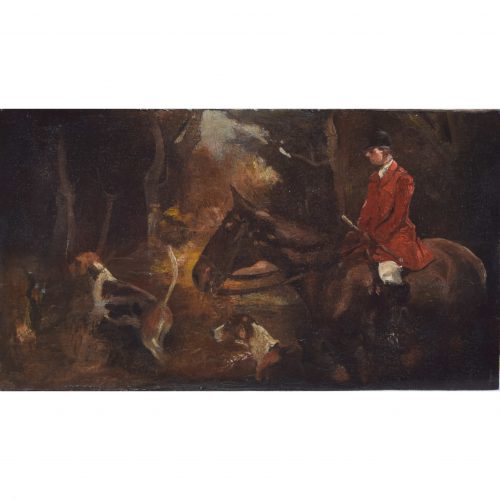
attr. John Ivester Lloyd (1873 - 1942)
Foxhunting
Oil on board 20 x 36 cm A huntsman and hounds pass through a dark wood. Thomas Ivester Lloyd (1873 - 1942) was born in Liverpool. During the First World War, he served with the Remount Service, in common with many other equine artists. He was later commissioned into the Royal Artillery. From childhood he hunted, and he became Master of the Sherington Foot Beagles. As well as his equine portraits, he illustrated some books. The pony books he illustrated were all written by his son, John Ivester-Lloyd. Condition: good; some craquelure. If you’d like to know more, please email info@manningfineart.co.uk or call us on 07929 749056. -
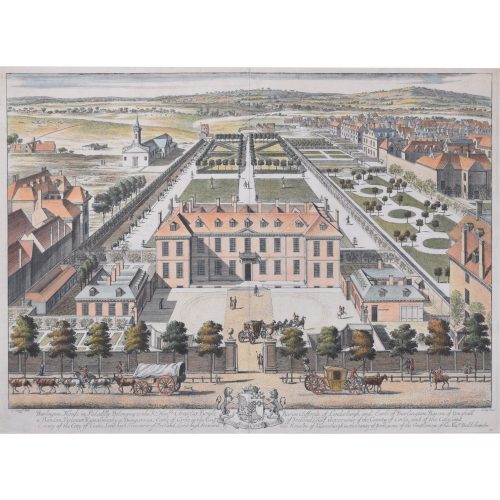
Johannes Kip (1652 - 1722) and Leonard Knyff (1650 - 1722)
Burlington House (1707)
Engraving with later hand-colouring 36 x 50 cm The linked careers of Jan Kip and Leonard Knyff made a specialty of engraved views of English country houses, represented in detail from the bird's-eye view, a pictorial convention for topography. Their major work was Britannia Illustrata: Or Views of Several of the Queens Palaces, as Also of the Principal seats of the Nobility and Gentry of Great Britain, Curiously Engraven on 80 Copper Plates, London (1707, published in the winter of 1708-9). The volume is among the most important English topographical publications of the 18th century. Architecture is rendered with care, and the settings of parterres and radiating avenues driven through woods or planted across fields, garden paths, gates and toolsheds are illustrated in detail. The images are staffed with figures and horses, coaches pulling into forecourts, water-craft on rivers, in line with the traditions of the Low Countries. The inscription in the plate reads: Burlington House in Pickadilly Belonging to the R.t Honble Charles Boyle Baron Clifforde of Londesburgh, and Earle of Burlington Baron of younghall & Bandon, Viscount Kynalmeaky & Dungarvan, Earle of Corke in the Kingdom of Ireland, Chief Governour of the County of Corke, and the Citty, and County of the Citty of Corke, Lord high Treasurer of Ireland, Lord high Steward of the Royalty of Knaresburgh in the County of Yorke, & one of the Gentlemen of his Majties Beddchamber. Condition: recent hand colouring, with wash-lined mount. If you’d like to know more, please email info@manningfineart.co.uk or call us on 07929 749056. -
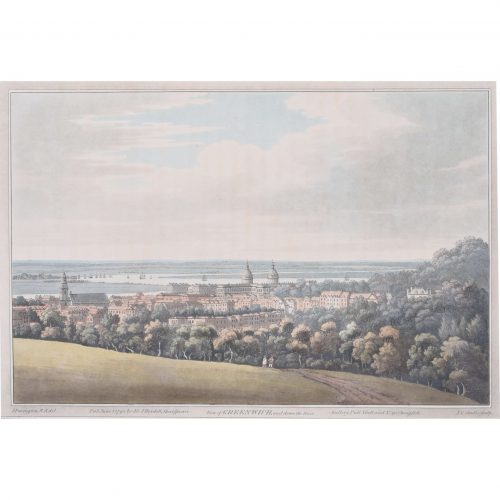
Joseph Constantine Stadler (1755 - 1828) after Joseph Farington (1747 - 1821)
View of Greenwich and Down the River (1795)
Hand-coloured engraving 23 x 33 cm Joseph Constantine Stadler was a prolific German émigré engraver of images after his contemporaries - here, 18th-century English landscape painter and diarist Joseph Farington. Stadler's engravings are wide-ranging in subject matter and include landscapes, seascapes and portraits, as well as military, sporting and decorative subjects. Stadler was employed by the leading print publisher of the time, John Boydell. Stadler lived in Knightsbridge when he died at the age of 73. Joseph Farington was born in Lancashire and went to study with Richard Wilson in London in 1763. In 1764, 1765, and 1766 he won "premiums" from the Society of Artists for his landscape drawing; he became a member in 1765. He joined the Royal Academy when it was founded in 1769 and was elected an ARA in 1783 and an RA in 1785. Farington contributed works to the Academy's exhibitions every year until 1801, but only occasionally between 1801 and 1813. He was an active member of the Academy and sat on several important committees, including the one which determined where artworks would be hung during the exhibitions. In 1793 he became a fellow of the Society of Antiquaries and helped establish the British Institution. Condition: very good. If you’d like to know more, please email info@manningfineart.co.uk or call us on 07929 749056. -
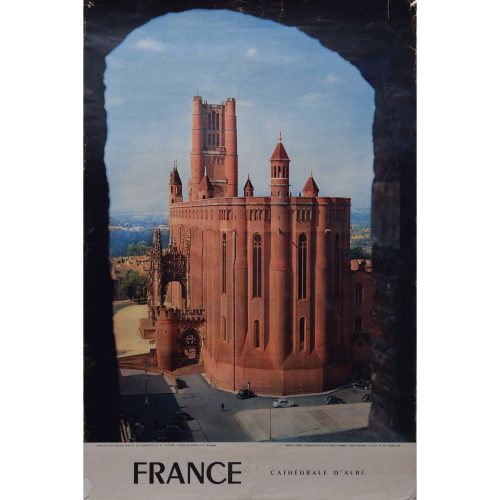
France - Cathedrale d'Albi, Toulouse
Original vintage poster 60 x 40 cm The Basilique Cathédrale Sainte-Cécile d'Albi (Cathedral Basilica of Saint Cecilia), also known as Albi Cathedral, is the seat of the Catholic Archbishop of Albi. First built in the aftermath of the Albigensian Crusade, the grim exterior resembles a fortress, but the interior is lavishly decorated with art and sculpture, a very ornate choir screen, and walls in bright blues and golds, in the Toulousian or Southern French Gothic. It was begun in 1282 and was under construction for 200 years. It is claimed to be the largest brick building in the world. In 2010 the cathedral, along with its episcopal buildings, was designated a UNESCO World Heritage Site because of its unique architecture and the remarkable consistency in its design. Condition: small tear to lower left corner; some wear to corners. If you’d like to know more, please email info@manningfineart.co.uk or call us on 07929 749056. -
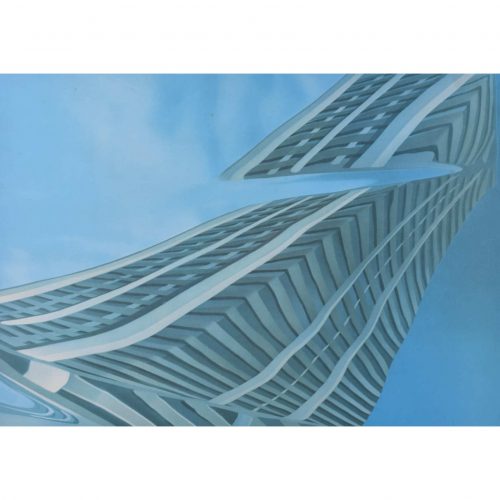
Brendan Neiland (b.1941) R.A. (Expelled)
Hyde Park Barracks, Knightsbridge (1979)
Screenprint 35 x 51 cm Signed, titled, dated and numbered 153/300 in pencil. A print of the facade of Hyde Park Barracks, reflected in still water and backed by a bright blue sky. Reflected architecture is one of Neiland's most recurring themes. The Hyde Park Barracks (often known as Knightsbridge Barracks) on the southern edge of Hyde Park. The barracks are 3⁄4 mile from Buckingham Palace, enabling the officers and soldiers of the Household Cavalry to be available to respond speedily to any emergency at the Palace, practice drills on the Horse Guards Parade, and conduct their ceremonial duties. Neiland is known for his interpretations of city life. His work is widely exhibited in major museums and galleries worldwide including, in Britain, the Victoria and Albert Museum, The Tate Gallery London, The Collections of the British Council and the Arts Council of Great Britain. He is represented by the Redfern Gallery and has had numerous shows internationally, including at the Galerie Belvedere in Singapore, who represent him in Singapore and the Far East. Condition: slight browning to sheet; small stain to top right corner. When mounted this will not be perceptible. If you’d like to know more, please email info@manningfineart.co.uk or call us on 07929 749056. -
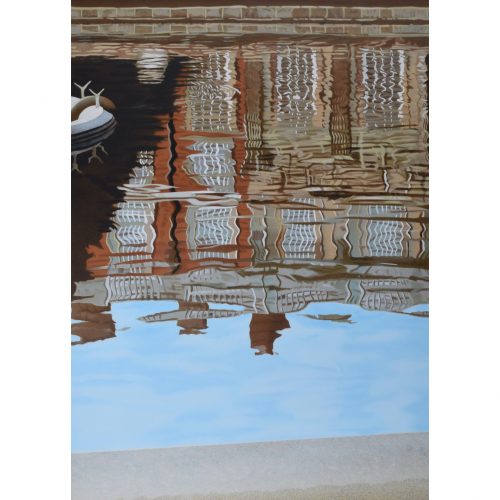
Brendan Neiland (b.1941) R.A. (Expelled)
Hampton Court (1984)
Screenprint 74 x 51 cm Signed, dated, titled, and numbered 152/250 in pencil. A print of one of Hampton Court's magnificent facades, reflected in its fountain. Reflected architecture is one of Neiland's most recurring themes. The Fountain Court was designed by Sir Christopher Wren; he began remodelled the palace in the baroque style for William III and Mary II in 1689. It held private and state apartments for both the King and Queen. Wren’s other works at Hampton Court Palace include the Lower Orangery and the grand colonnade in Clock Court, providing a grand entrance to the King's Apartments. The architectural historian Sir John Summerson described Fountain Court as 'Startling, as of simultaneous exposure to a great many eyes with raised eyebrows'. Brendan Neiland (born 23 October 1941 in Lichfield, Staffordshire) is an English artist best known for his paintings of reflections in modern city buildings. In 1992 he was elected to the Royal Academy (RA). Neiland is known for his interpretations of city life. His work is widely exhibited in major museums and galleries worldwide including, in Britain, the Victoria and Albert Museum, The Tate Gallery London, The Collections of the British Council and the Arts Council of Great Britain. He is represented by the Redfern Gallery and has had numerous shows internationally, including at the Galerie Belvedere in Singapore, who represent him in Singapore and the Far East. Condition: very good. If you’d like to know more, please email info@manningfineart.co.uk or call us on 07929 749056. -
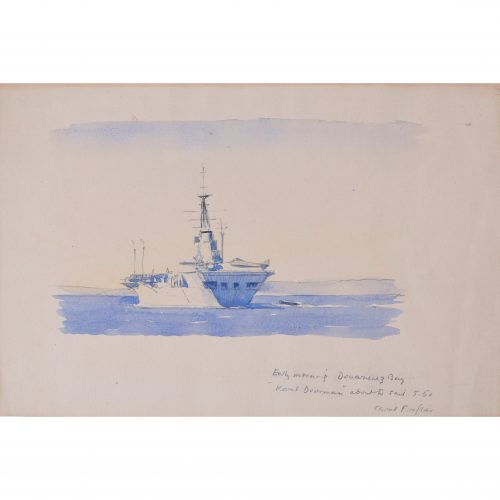
Laurence Dunn (1910-2006)
Karel Doorman About to Sail
Watercolour 15 x 23 cm (sheet size 99 x 73 cm) Signed to backing board, with extensive inscription by Dunn. HNLMS Karel Doorman (R81) was a Colossus-class aircraft carrier of the Royal Netherlands Navy. Formerly the British ship HMS Venerable, she was sold to the Netherlands in 1948 as a light attack carrier. In 1960, she was involved in the decolonization conflict in Western New Guinea with Indonesia. In the mid 1960s, her role was changed to anti-submarine warfare carrier and only ASW aircraft and helicopters were carried. An engine room fire took her out of service in 1968. She was sold to Argentina in 1969 and renamed ARA Veinticinco de Mayo. Laurence Dunn was an artist known for his depictions of ships. He grew up in Devon, where he practised drawing passing ships, and went on to study at the Central School of Art. He then worked for shipbuilding firm John I. Thornycroft & Company Limited, where he assisted with the design of the royal yacht.During the Second World War, Dunn worked for naval intelligence. In the early 1960s he created many line drawings of Atlantic ocean liners. The World Ship Society published the following obituary for Laurence Dunn in 2006: DUNN, Laurence. [December 15 2006 — Lloyds List] Many readers will be saddened by the death of well-known marine artist and writer Laurence Dunn in his 97th year. A man of encyclopaedic knowledge, he began his lifelong love of ships in Brixham, where he meticulously recorded passing traffic with the exquisitely accurate line drawings which later became something of a trademark. While studying at London’s Central School of Art his work was noticed by the Southern Railway, which commissioned profiles of its fleet, and this in turn led to work for Orient Line, where he also designed the well-known corn-coloured hull, and later Thorneycroft, where he helped with shaping draft plans for a new royal yacht. During the second world was he worked for naval intelligence at the Admiralty, where his technique did much to improve recognition standards, and greatly expanded his shipping clientele, becoming personally known to many chairmen. As well as the shipping press he worked for mainstream publications such as Everybody’s, Sphere and the upmarket comic Eagle. Through his many contacts he enjoyed going to sea in a great variety of ships from aircraft carriers to colliers. Laurence wrote several books, starting with ship recognition titles which introduced new standards of layout, but his best known work was probably Passenger Liners, which was widely taken up by the travel trade. His love of Greece, where he was an early publicist of island cruising, let to involvement in reshaping various passenger liners beginning with Greek Line’s OLYMPIA. In later life he designed several sets of shipping stamps for the Crown Agents, produced photographic volumes on Thames and Mediterranean shipping and still found time to enjoy the passing Thames traffic. Our sympathies go to his wife Jennifer, who provided succour to the many ship lovers who beat a path to the welcoming door of their Gravesend home. Condition: very good. If you'd like to know more, please email info@manningfineart.co.uk or call us on 07929 749056. -
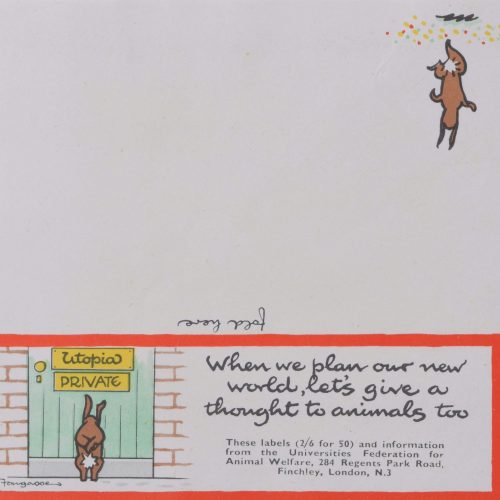
Fougasse (Cyril Kenneth Bird, 1887 - 1965)
'When we plan our new world, let's give a thought to animals too'
Lithograph 11 x 11 cm Cyril Kenneth Bird, under the name Fougasse, was a British cartoonist. He was art editor of Punch 1937 - 1949, and subsequently editor until 1953. He is best known for his ‘Careless Talk Costs Lives’ series of posters, and produced many other posters for the Ministry of Information and London Underground. His pen and ink cartoons for Punch are some of his gentlest and funniest works. What is less widely known about Fougasse is that he was a keen animal welfare activist. He became the chairman of the Universities' Federation for Animal Welfare after the war, and illustrated many of the Federation's campaigns. This label is one such illustration, and encourages the post-war re-evaluation of society to take into account the welfare of animals as well as that of humans. Condition: good. Small soft crease to top right corner. If you’d like to know more, please email info@manningfineart.co.uk or call us on 07929 749056. -

Gordon House (1932 - 2004)
Triangle E
Lithograph 86 x 45 cm Signed and titled in pencil below the plate. An excellent example of Gordon House's work: a modern design in several tones of blue. Gordon House was born in Pontardawe, South Wales in 1932 and studied at Luton and St. Albans Schools of Art. He began working for advertising agencies in the 1950s and became a full-time artist in 1961, exhibiting several solo shoes. He designed for several leading London galleries, the Ashmolean Museum in Oxford, and popular bands such as the Beatles and the Rolling Stones. Several dozen Gordon House prints are held by the Tate. Condition: very good. Mounted to board. If you’d like to know more, please email info@manningfineart.co.uk or call us on 07929 749056. -
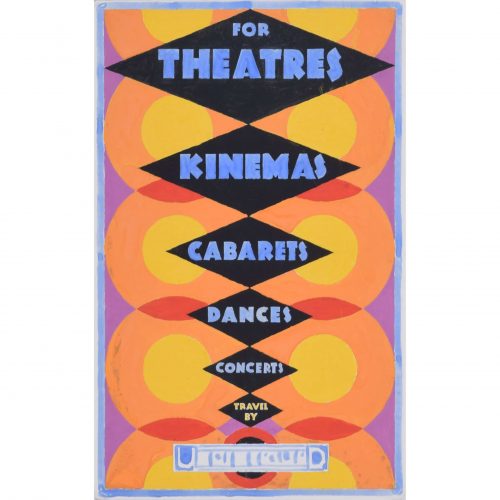
Gerald Mac Spink (flourished 1920 - 1940)
For Theatres, Kinemas, Cabarets, Dances, Concerts, Travel by Underground (c. 1930)
Gouache 30 x 19 cm Original design for a London Transport poster. Framed. A fantastic gouache design by Spink for a London Underground poster. The artist's striking Art Deco design and heady use of colour advertises the glamour of travelling by Tube to various evening entertainments around London. Spink was a skilled artist and designer who produced a series of posters in the inter-war period for companies including the London Underground, Southern Railways, LNER, Hawker Engineering, and British Steel. He won a prize in 1933 from the Imperial Institute for his poster artwork. He also worked as an aeronautical engineer in Kingston-on-Thames for Hawker Engineering; his greatest achievement was the creation of the 'Squanderbug', a 500cc racing car which he built in 1947, and which races even to this day. Provenance: the artist's estate. Condition: good; a few small scuffs to gouache, as visible in photographs. Handsomely framed. If you’d like to know more, please email info@manningfineart.co.uk or call us on 07929 749056. -
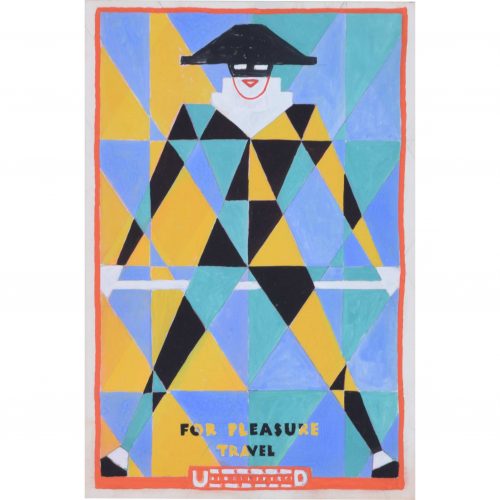
Gerald Mac Spink (flourished 1920 - 1940)
For Pleasure, Travel by Underground (c. 1930)
Gouache 26 x 18 cm Original design for a London Transport poster. Framed. A dynamic Art Deco poster design by Mac Spink. A boldly-coloured harlequin figure encourages travel via the London Underground. Spink was a skilled artist and designer who produced a series of posters in the inter-war period for companies including the London Underground, Southern Railways, LNER, Hawker Engineering, and British Steel. He won a prize in 1933 from the Imperial Institute for his poster artwork. He also worked as an aeronautical engineer in Kingston-on-Thames for Hawker Engineering; his greatest achievement was the creation of the 'Squanderbug', a 500cc racing car which he built in 1947, and which races even to this day. Provenance: the artist's estate. Condition: good; a few small scuffs to gouache, as visible in photographs. Handsomely framed. If you’d like to know more, please email info@manningfineart.co.uk or call us on 07929 749056. -
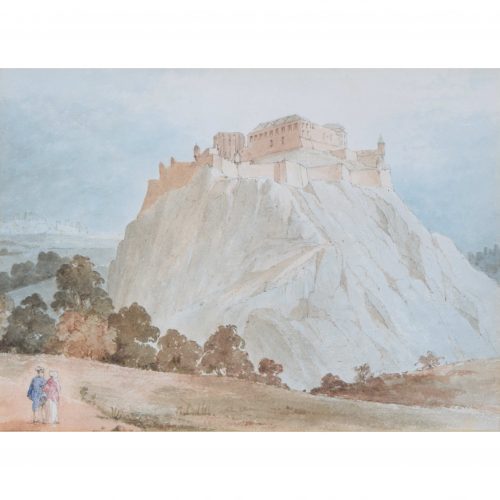
Richard Westmacott (1775 - 1856)
Edinburgh Castle (1800)
Watercolour 29 x 41 cm A watercolour depicting Edinburgh Castle. A Georgian couple gaze up at the immensity of Castle Rock, and the 11th-century fortress perched upon it. Richard Westmacott was British artist who primarily worked as a sculptor. Westmacott studied with his father, also named Richard Westmacott, at his studio in Mount Street, off Grosvenor Square in London, before going to Rome in 1793 to study under Antonio Canova. Upon his return to London in 1797, he established his own studio. He exhibited at the Royal Academy between 1797 and 1839 and was elected an associate of the Royal Academy in 1805, and a full academician in 1811. Condition: very good; handsomely framed. If you’d like to know more, please email info@manningfineart.co.uk or call us on 07929 749056. -
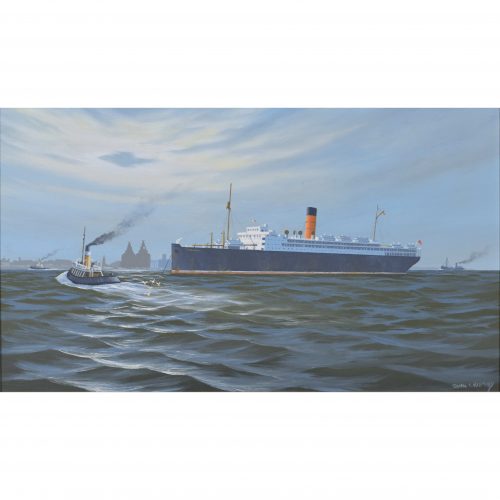
John Cromby (20th century)
A Passenger Ship in Liverpool Harbour
Oil on board 34 x 59 cm Signed lower right. A liner steers between a bright blue sky and a deep blue sea. Small steamships sail nearby, and seagulls wind their way among the various vessels. In the background, Liverpool's skyline is silhouetted. Cromby was a Liverpool-based artist, renowned for his paintings of Liverpool docks. Condition: excellent. If you’d like to know more, please email info@manningfineart.co.uk or call us on 07929 749056. -
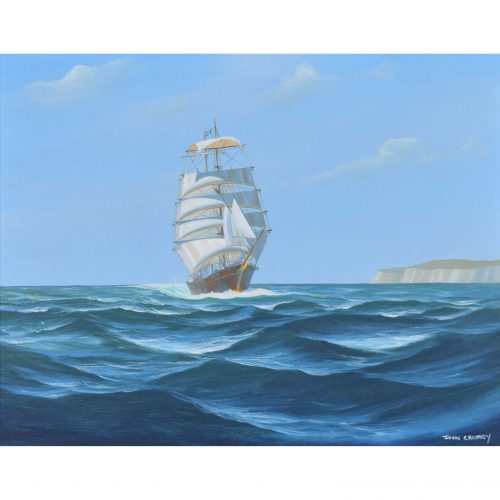
John Cromby (20th century)
Berean
Oil on board 38 x 49 cm Signed lower right. The Berean emerges from the horizon between a choppy sea and blue sky studded with clouds. The Berean was built by William Pile of Sunderland for Thomas B Walker of London in 1869, and was one of the fastest ships on the London-Tasmania run. The Berean was inward-bound from Langesund, Norway, with a cargo of ice, when she was struck by a foreign steamship and foundered on the 8th April 1910. In Cromby's painting, a grey-green headland emerges from the right of the picture. Cromby was a Liverpool-based artist, renowned for his paintings of Liverpool docks. Condition: excellent. If you’d like to know more, please email info@manningfineart.co.uk or call us on 07929 749056. -
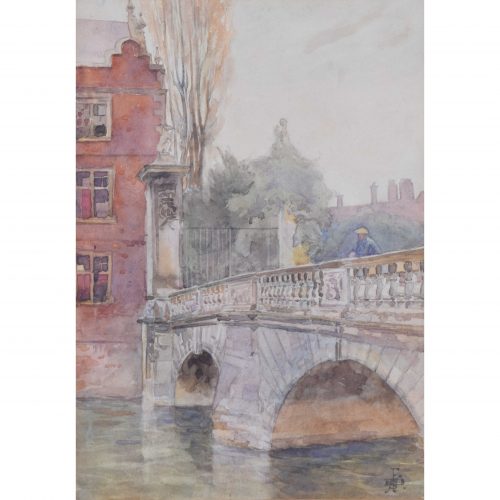
The Wren Bridge, St John's College, Cambridge
Engraving 35 x 24 cm Signed as a cypher lower right. A 1911 watercolour of St John's College's Wren Bridge, also known as the Kitchen Bridge. There had been a wooden bridge in this location since the early days of the medieval Hospital of St John the Evangelist. Christopher Wren had submitted designs to St John’s for a stone bridge in the 1690s, but building work did not commence until 1709. The Wren Bridge was completed in 1713. Its construction was overseen by Robert Grumbold, a local master stonemason and architect who was also responsible for building the Wren Library at Trinity College. The bridge reflects Wren's design, although in his original drawings he had suggested urns and pyramids, which were never added. In this view, a lone figure gazes down from the bridge into the muddy waters of the River Cam. Condition: very good. If you’d like to know more, please email info@manningfineart.co.uk or call us on 07929 749056. -
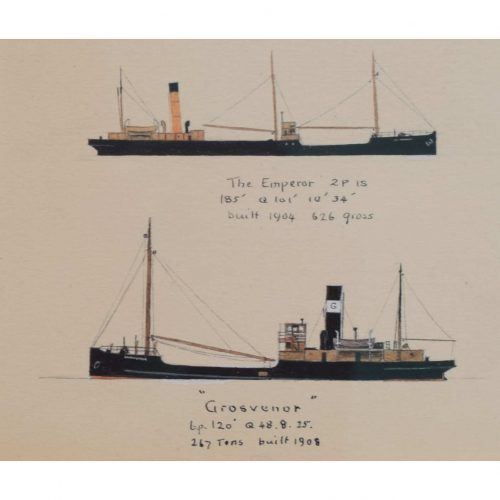
Laurence Dunn (1910 - 2006)
The Emperor and Grosvenor
Watercolour 8 x 9 cm Laurence Dunn was an artist known for his depictions of ships. He grew up in Devon, where he practised drawing passing ships, and went on to study at the Central School of Art. He then worked for shipbuilding firm John I. Thornycroft & Company Limited, where he contributed to the design of the Royal Yacht. During the Second World War, Dunn worked in naval intelligence. In the early 1960s, he created many line drawings of Atlantic ocean liners. The World Ship Society published the following obituary for Laurence Dunn in 2006: DUNN, Laurence. [December 15 2006 — Lloyds List] Many readers will be saddened by the death of well-known marine artist and writer Laurence Dunn in his 97th year. A man of encyclopaedic knowledge, he began his lifelong love of ships in Brixham, where he meticulously recorded passing traffic with the exquisitely accurate line drawings which later became something of a trademark. While studying at London’s Central School of Art his work was noticed by the Southern Railway, which commissioned profiles of its fleet, and this in turn led to work for Orient Line, where he also designed the well-known corn-coloured hull, and later Thorneycroft, where he helped with shaping draft plans for a new royal yacht. During the second world was he worked for naval intelligence at the Admiralty, where his technique did much to improve recognition standards, and greatly expanded his shipping clientele, becoming personally known to many chairmen. As well as the shipping press he worked for mainstream publications such as Everybody’s, Sphere and the upmarket comic Eagle. Through his many contacts he enjoyed going to sea in a great variety of ships from aircraft carriers to colliers. Laurence wrote several books, starting with ship recognition titles which introduced new standards of layout, but his best known work was probably Passenger Liners, which was widely taken up by the travel trade. His love of Greece, where he was an early publicist of island cruising, let to involvement in reshaping various passenger liners beginning with Greek Line’s OLYMPIA. In later life he designed several sets of shipping stamps for the Crown Agents, produced photographic volumes on Thames and Mediterranean shipping and still found time to enjoy the passing Thames traffic. Our sympathies go to his wife Jennifer, who provided succour to the many ship lovers who beat a path to the welcoming door of their Gravesend home. Condition: very good. If you'd like to know more, please email info@manningfineart.co.uk or call us on 07929 749056. -
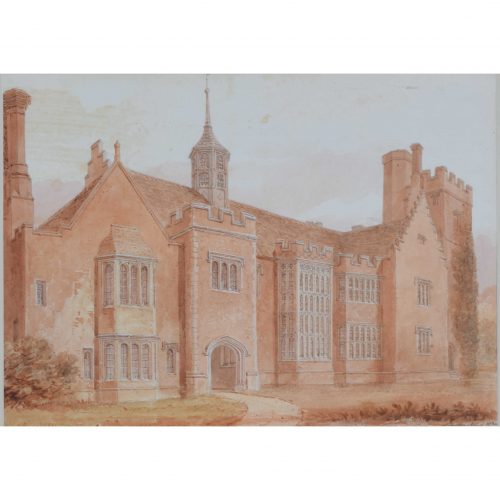
John Chessell Buckler (1793 - 1894)
Horham Hall, Essex (1830)
Watercolour 25 x 34 cm Signed and dated lower right; titled below. Horham Hall was built in Thaxted, Essex by Sir John Cutte in the early sixteenth century. The original hall was a timber-framed moated manor house built circa 1470, but it was largely demolished by Cutte, who built the present house between 1510 and 1515. Cutte was under-treasurer in the households of Henry VII and Henry VIII. The mansion was built in brick in two storeys in a quadrilateral layout with a gatehouse and incorporated some elements of the former building. The house was visited three times by Elizabeth I as the guest of Sir John Cutte. It is believed that the Tower was built for her to watch the local hunt. It was while staying at Horham in 1578 that the Queen received the envoy of the Duke of Alençon proposing marriage. John Chessell Buckler was a British architect, the eldest son of the architect John Buckler. His work included restorations of country houses and at the University of Oxford. Buckler received art lessons from the painter Francis Nicholson. He began working for his father's architectural practice in 1810, and ran it from 1830 onwards with his younger brother George. They worked in partnership until 1842. Buckler did a lot of work in Oxford, carrying out repairs and additions to St. Mary's Church, and Oriel, Brasenose, Magdalen, and Jesus Colleges. He also restored Oxburgh Hall, Norfolk, and Hengrave Hall, Suffolk, and designed Dunston Hall, Norfolk, and Butleigh Court in Somerset. In 1836 he came second, behind Charles Barry, in the competition to rebuild the Palace of Westminster following its destruction by fire. Buckler's writings included the text accompanying his father's engravings of Views of the Cathedral Churches of England and Wales (1822). In 1823 he published 'Observations on the Original Architecture of St. Mary Magdalen College, Oxford', in which he expressed his hostility towards changes in the quadrangle of Magdalen College. Some of his later writings, such as 'A History of the Architecture of the Abbey Church of St Alban' (1847), were written in collaboration with his own son, Charles Alban Buckler. He wrote a further polemical work, 'A Description And Defense Of The Restorations Of The Exterior Of Lincoln Cathedral' (1866), a scathing response to accusations that, in capacity as honorary architect to Lincoln Cathedral, he had overseen a damaging restoration involving the 'scraping' of the cathedral fabric. He died at the grand old age of 100 in 1894. Condition: good. Some spots to the sky, as visible in photograph. If you’d like to know more, please email info@manningfineart.co.uk or call us on 07929 749056. -
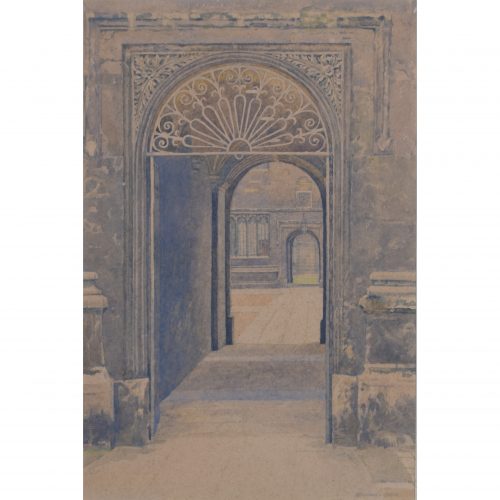
Bernard Cecil Gotch (1876-1964)
The Bodleian Library, Oxford: Passageway into the Old Schools Quandrangle
Watercolour 49 x 35 cm Signed in pencil lower right. An enticing view of the passageway leading into the Old Schools Quad of the Bodleian Library. Through the gateway, we see the passageway leading out of the Quad onto the other side, into Radcliffe Square. A glimpse of the Radcliffe Camera, surrounded by its green lawn, is visible through the two passages. Bernard Cecil Gotch was a Winchester-born artist who is best known for his atmospheric watercolours of Britain's towns and cities (most notably Oxford). He moved to Oxford in 1927, painting many watercolours of the interiors and exteriors of Oxford’s many buildings. His works concentrate on the grand exteriors and interiors of the University's colleges, and he exhibited frequently - including an exhibition every term at Oriel College. His first notable commission was for the publisher Methuen, illustrating 'A Shepherd’s Life' by W H Hudson. Whilst in London he was invited to illustrate a book on the Public Schools of England (which was sadly never completed). He exhibited watercolours at the Fine Art Society and Lincolns Inn, and also exhibited at the Royal Academy. In 1952 Gotch was given an Honorary MA by the University of Oxford, and, after his death in 1963, a memorial was held for him at Oriel. Condition: very good. Framed, with washline mount. If you’d like to know more, please email info@manningfineart.co.uk or call us on 07929 749056. -
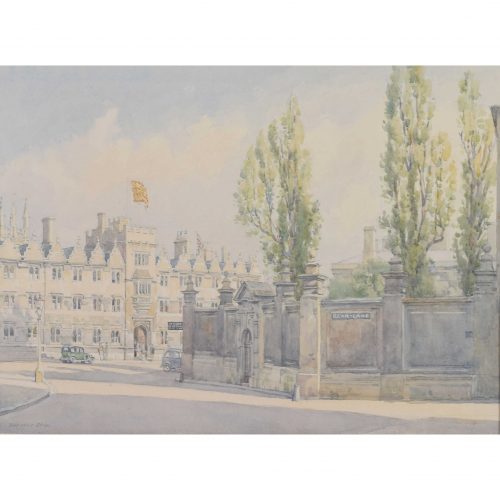
Bernard Cecil Gotch (1876-1964)
Oriel Square, Oxford, at the entrance to Bear Lane
Watercolour 27 x 36.5 cm Signed in pencil lower left. Oriel Square in the afternoon. Two undergraduates lean against the walls of Oriel College, talking, and another group make their way inside. Vintage cars (dating the picture to the 1920s, or 1930s?) are parked outside its gates, and the Oriel flag flies high. Bernard Cecil Gotch was a Winchester-born artist who is best known for his atmospheric watercolours of Britain's towns and cities (most notably Oxford). He moved to Oxford in 1927, painting many watercolours of the interiors and exteriors of Oxford’s many buildings. His works concentrate on the grand exteriors and interiors of the University's colleges, and he exhibited frequently - including an exhibition every term at Oriel College. His first notable commission was for the publisher Methuen, illustrating 'A Shepherd’s Life' by W H Hudson. Whilst in London he was invited to illustrate a book on the Public Schools of England (which was sadly never completed). He exhibited watercolours at the Fine Art Society and Lincolns Inn, and also exhibited at the Royal Academy. In 1952 Gotch was given an Honorary MA by the University of Oxford, and, after his death in 1963, a memorial was held for him at Oriel. Condition: very good. If you’d like to know more, please email info@manningfineart.co.uk or call us on 07929 749056. -

John Appleyard (1908 - 1960)
The Middleton Hunt at Sherriff Hutton
Watercolour 28 x 37 cm Signed lower right. The Huntsman and hounds of North Yorkshire's Middleton Hunt. Condition: very good. If you’d like to know more, please email info@manningfineart.co.uk or call us on 07929 749056. -
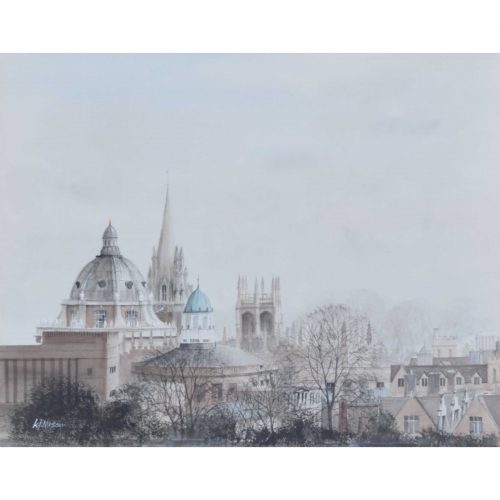
Ken Messer (1931 - 2018)
Dreaming Spires
Watercolour 30 x 38 cm Signed lower left. Oxford's skyline, including the Radcliffe Camera, the spire of University Church of St Mary the Virgin, and Magdalen Tower, is silhouetted against the grey sky of a winter day. The trees in the foreground are stark and black. Messer's depiction of Oxford's dreaming spires is an outstanding architectural record of the city's - and University's - most remarkable buildings. The painter and draughtsman Ken Messer is closely related to Oxford and its architecture in several ways. Born in Newport, South Wales, he was educated at the City of Oxford High School for Boys in Oxford, and then spent six years working as an accountant in Oxford. He then joined British Overseas Airways Corporation (BOAC) as a steward, flying internationally. Injury due to a car accident during the 1960s meant that he joined the design department of Pergamon Press in Oxford at the age of 33. Six years later, he was appointed to the position of studio manager, in charge of art and design. In 1974, Messer left Pergamon Press to become a freelance graphic designer. He started painting more watercolours, becoming a full-time artist. During the 1980s, his ink drawings were regularly published in the Oxford Times. He has sometimes been called "The Oxford Artist" because of his large number of works depicting Oxford. He and his wife Dilys lived at first in Richmond upon Thames and then in Abingdon, just south of Oxford. Messer's work has been shown at the Mall Galleries for the annual exhibitions of the Royal Institute of Painters in Water Colours annual exhibitions. Condition: excellent. If you’d like to know more, please email info@manningfineart.co.uk or call us on 07929 749056. -
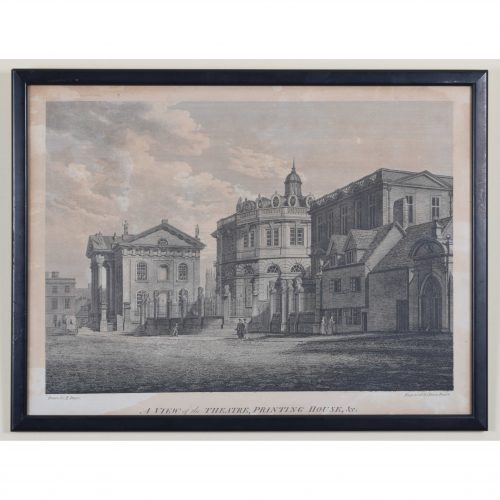
James Basire II (1769 - 1822) after Edward Dayes (1763 - 1804)
A View of the Theatre, Printing House, & c. (1800)
Engraving 36 x 49 cm A view of Broad Street, showing the Clarendon Building, Sheldonian Theatre, and what is now the Museum of the History of Science. Edward Dayes' drawing was reproduced as a lithograph in 1800, to be published in the "Oxford Almanack". The Oxford Almanack was an annual almanack published by the Oxford University Press for the University of Oxford from 1674 through 2019 (when printing sadly ceased due to "dwindling interest"). The almanack traditionally included engravings or lithographs of the University and information about the upcoming year. Other almanack artists have included Michael Burghers, J. M. W. Turner, and John Piper. Basire and Dayes collaborated on several views of Oxford during the courses of their careers. Edward Dayes was a British painter and engraver. He exhibited topographical views at the Royal Academy from 1786 until his death, and is the author of an ''Excursion through Derbyshire and Yorkshire,'' ''Essays on Painting; Instructions for Drawing and Colouring Landscapes'', and ''Professional Sketches of Modem Artists''. James Basire II was a British engraver, son of James Basire I, also a celebrated engraver. In 1802 he became Engraver to the Society of Antiquaries. Condition: some browning, as visible in photograph. If you’d like to know more, please email info@manningfineart.co.uk or call us on 07929 749056. -

J Black (early 19th century) after Frederick Mackenzie (1788 - 1854)
The Choir, Westminster Abbey (1812)
Hand-coloured aquatint 28 x 19 cm Published by Rudolph Ackermann (1764 - 1834). An engraving of the vast and soaring interior of Westminster Abbey. Mackenzie's drawing was engraved by Black and published by Ackermann in his 1812 "History of Westminster Abbey". The Abbey is an historic, mainly Gothic church in the City of Westminster, London, just to the west of the Palace of Westminster. It is one of the United Kingdom's most notable religious buildings and since Edward the Confessor, a burial site for English and, later, British monarchs. Since the coronation of William the Conqueror in 1066, all coronations of English and British monarchs have occurred in Westminster Abbey. Sixteen royal weddings have occurred at the abbey since 1100. According to a tradition first reported circa 1080, a church was founded at the site (then known as Thorney Island) in the seventh century, in the time of Mellitus, Bishop of London. Construction of the present church began in 1245 on the orders of Henry III. Frederick Mackenzie (1788 - 1854) was a British watercolourist and architectural draughtsman. He first exhibited at the Royal Academy in 1804, and contributed eleven drawings between that year and 1828. He contributed to the Society of Painters in Water Colours exhibitions from 1813, becoming an associate in 1822, and a full member the following year. From 30 November 1831 till his death he was treasurer to the society. In later life Mackenzie was no longer commissioned to illustrate books. Rudolph Ackermann was an Anglo-German bookseller, inventor, lithographer, publisher and businessman. In 1795 he established a print-shop and drawing-school at 96 Strand. Here Ackermann set up a lithographic press and began a trade in prints. He later began to manufacture colours and thick carton paper for landscape and miniature painters. Within three years the premises had become too small and he moved to 101 Strand, in his own words "four doors nearer to Somerset House", the seat of the Royal Academy of Arts. Between 1797 and 1800 Ackermann rapidly developed his print and book publishing business, encompassing many different genres including topography, caricature, portraits, transparencies and decorative prints. Condition: good. Some age toning. If you’d like to know more, please email info@manningfineart.co.uk or call us on 07929 749056. -
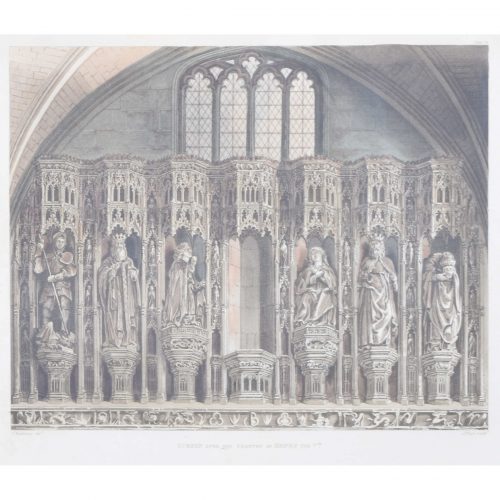
J Black (early 19th century) after Frederick Mackenzie (1788 - 1854)
Screen Over the Chantry of Henry V, Westminster Abbey (1812)
Hand-coloured aquatint 26 x 31 cm Published by Rudolph Ackermann (1764 - 1834). An engraving of the gothic screen of the elaborately carved chantry chapel dedicated to Henry V, and below which lies his tomb, in Westminster Abbey. Mackenzie's drawing was engraved by Black and published by Ackermann in his 1812 "History of Westminster Abbey". The Abbey is an historic, mainly Gothic church in the City of Westminster, London, just to the west of the Palace of Westminster. It is one of the United Kingdom''s most notable religious buildings and since Edward the Confessor, a burial site for English and, later, British monarchs. Since the coronation of William the Conqueror in 1066, all coronations of English and British monarchs have occurred in Westminster Abbey. Sixteen royal weddings have occurred at the abbey since 1100. According to a tradition first reported circa 1080, a church was founded at the site (then known as Thorney Island) in the seventh century, in the time of Mellitus, Bishop of London. Construction of the present church began in 1245 on the orders of Henry III. Frederick Mackenzie (1788 - 1854) was a British watercolourist and architectural draughtsman. He first exhibited at the Royal Academy in 1804, and contributed eleven drawings between that year and 1828. He contributed to the Society of Painters in Water Colours exhibitions from 1813, becoming an associate in 1822, and a full member the following year. From 30 November 1831 till his death he was treasurer to the society. In later life Mackenzie was no longer commissioned to illustrate books. Rudolph Ackermann was an Anglo-German bookseller, inventor, lithographer, publisher and businessman. In 1795 he established a print-shop and drawing-school at 96 Strand. Here Ackermann set up a lithographic press and began a trade in prints. He later began to manufacture colours and thick carton paper for landscape and miniature painters. Within three years the premises had become too small and he moved to 101 Strand, in his own words "four doors nearer to Somerset House", the seat of the Royal Academy of Arts. Between 1797 and 1800 Ackermann rapidly developed his print and book publishing business, encompassing many different genres including topography, caricature, portraits, transparencies and decorative prints. Condition: good. Some age toning. If you’d like to know more, please email info@manningfineart.co.uk or call us on 07929 749056. -
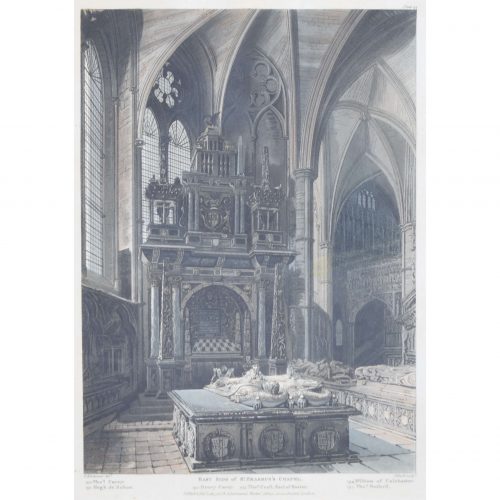
J Black (early 19th century) after Frederick Mackenzie (1788 - 1854)
East Side of St Erasmus' Chapel, Westminster Abbey (1812)
Hand-coloured aquatint 28 x 19 cm Published by Rudolph Ackermann (1764 - 1834). An engraving of the east side of the chapel of St Erasmus in Westminster Abbey. Mackenzie's drawing was engraved by Black and published by Ackermann in his 1812 "History of Westminster Abbey". The chapel was built in the late 15th century by order of Edward IV's wife, Elizabeth Woodville. It would have been used to worship St Erasmus, also known as St Elmo (a Christian saint and martyr venerated as the patron saint of sailors and abdominal pain). The Abbey is an historic, mainly Gothic church in the City of Westminster, London, just to the west of the Palace of Westminster. It is one of the United Kingdom's most notable religious buildings and since Edward the Confessor, a burial site for English and, later, British monarchs. Since the coronation of William the Conqueror in 1066, all coronations of English and British monarchs have occurred in Westminster Abbey. Sixteen royal weddings have occurred at the abbey since 1100. According to a tradition first reported circa 1080, a church was founded at the site (then known as Thorney Island) in the seventh century, in the time of Mellitus, Bishop of London. Construction of the present church began in 1245 on the orders of Henry III. Frederick Mackenzie (1788 - 1854) was a British watercolourist and architectural draughtsman. He first exhibited at the Royal Academy in 1804, and contributed eleven drawings between that year and 1828. He contributed to the Society of Painters in Water Colours exhibitions from 1813, becoming an associate in 1822, and a full member the following year. From 30 November 1831 till his death he was treasurer to the society. In later life Mackenzie was no longer commissioned to illustrate books. Rudolph Ackermann was an Anglo-German bookseller, inventor, lithographer, publisher and businessman. In 1795 he established a print-shop and drawing-school at 96 Strand. Here Ackermann set up a lithographic press and began a trade in prints. He later began to manufacture colours and thick carton paper for landscape and miniature painters. Within three years the premises had become too small and he moved to 101 Strand, in his own words "four doors nearer to Somerset House", the seat of the Royal Academy of Arts. Between 1797 and 1800 Ackermann rapidly developed his print and book publishing business, encompassing many different genres including topography, caricature, portraits, transparencies and decorative prints. Condition: good. Some age toning. If you’d like to know more, please email info@manningfineart.co.uk or call us on 07929 749056. -
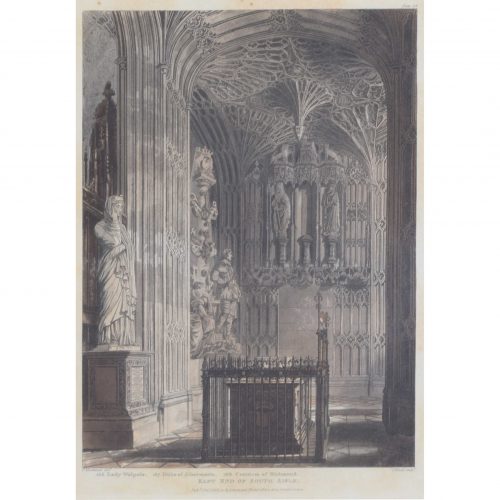
J Black (early 19th century) after Frederick Mackenzie (1788 - 1854)
East End of South Aisle, Westminster Abbey (1812)
Hand-coloured aquatint 31 x 24 cm Published by Rudolph Ackermann (1764 - 1834). An engraving of the East End of Westminster Abbey's south aisle. Mackenzie's drawing was engraved by Black and published by Ackermann in his 1812 "History of Westminster Abbey". Charles II, Queen Anne, Queen Mary II and her husband King William III, and Mary, Queen of Scots are all buried in the south aisle. The Abbey is an historic, mainly Gothic church in the City of Westminster, London, just to the west of the Palace of Westminster. It is one of the United Kingdom's most notable religious buildings and since Edward the Confessor, a burial site for English and, later, British monarchs. Since the coronation of William the Conqueror in 1066, all coronations of English and British monarchs have occurred in Westminster Abbey. Sixteen royal weddings have occurred at the abbey since 1100. According to a tradition first reported circa 1080, a church was founded at the site (then known as Thorney Island) in the seventh century, in the time of Mellitus, Bishop of London. Construction of the present church began in 1245 on the orders of Henry III. Frederick Mackenzie (1788 - 1854) was a British watercolourist and architectural draughtsman. He first exhibited at the Royal Academy in 1804, and contributed eleven drawings between that year and 1828. He contributed to the Society of Painters in Water Colours exhibitions from 1813, becoming an associate in 1822, and a full member the following year. From 30 November 1831 till his death he was treasurer to the society. In later life Mackenzie was no longer commissioned to illustrate books. Rudolph Ackermann was an Anglo-German bookseller, inventor, lithographer, publisher and businessman. In 1795 he established a print-shop and drawing-school at 96 Strand. Here Ackermann set up a lithographic press and began a trade in prints. He later began to manufacture colours and thick carton paper for landscape and miniature painters. Within three years the premises had become too small and he moved to 101 Strand, in his own words "four doors nearer to Somerset House", the seat of the Royal Academy of Arts. Between 1797 and 1800 Ackermann rapidly developed his print and book publishing business, encompassing many different genres including topography, caricature, portraits, transparencies and decorative prints. Condition: good. Some age toning. If you’d like to know more, please email info@manningfineart.co.uk or call us on 07929 749056. -
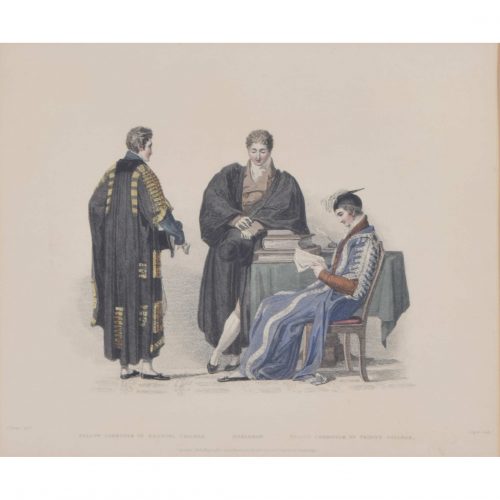
John Samuel Agar (1773 - 1858) after John Uwins (1782 - 1857)
Fellow Commoner of Emanuel College; a Nobleman; Fellow Commoner of Trinity College (1815)
Hand-coloured aquatint 25 x 29.5 cm Published by Rudolph Ackermann (1764 - 1834). An engraving of two students and a nobleman from Ackermann's ''A History of the University of Cambridge, Its Colleges, Halls and Public Buildings''. The three figures dwell over a pile of books and papers, clad in the appropriate academic dress. Thomas Uwins RA RWS was a British painter in watercolour and oil, and a book illustrator. He became a full member of the Old Watercolour Society and a Royal Academician, and held a number of high-profile art appointments including the librarian of the Royal Academy, Surveyor of Pictures to Queen Victoria and the Keeper of the National Gallery. In the late 1790s he began producing work for Ackermann''s collections. John Samuel Agar was an English portrait painter and engraver, who exhibited his works at the Royal Academy from 1796 to 1806 and at the British Institution until 1811. He was at one time president of the Society of Engravers. Rudolph Ackermann published many of his engravings. Rudolph Ackermann was an Anglo-German bookseller, inventor, lithographer, publisher and businessman. In 1795 he established a print-shop and drawing-school at 96 Strand. Here Ackermann set up a lithographic press and began a trade in prints. He later began to manufacture colours and thick carton paper for landscape and miniature painters. Within three years the premises had become too small and he moved to 101 Strand, in his own words "four doors nearer to Somerset House", the seat of the Royal Academy of Arts. Between 1797 and 1800 Ackermann rapidly developed his print and book publishing business, encompassing many different genres including topography, caricature, portraits, transparencies and decorative prints. Condition: good. Some age toning. If you’d like to know more, please email info@manningfineart.co.uk or call us on 07929 749056. -
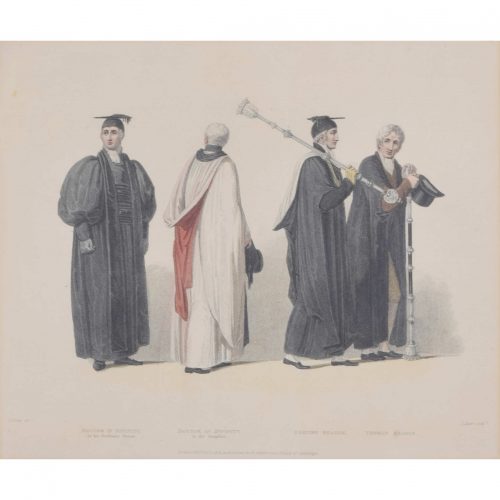
John Samuel Agar (1773 - 1858) after John Uwins (1782 - 1857)
Doctors in Divinity, Esquire Beadle, and Yeoman Beadle (1815)
Hand-coloured aquatint 25 x 30 cm Published by Rudolph Ackermann (1764 - 1834). An engraving of two Doctors in Divinity and two beadles (administrative assistants to the Chancellor and Proctors of the University) from Ackermann's ''A History of the University of Cambridge, Its Colleges, Halls and Public Buildings''. The four figures walk forward with ceremonial accoutrements, likely to a graduation ceremony. Thomas Uwins RA RWS was a British painter in watercolour and oil, and a book illustrator. He became a full member of the Old Watercolour Society and a Royal Academician, and held a number of high-profile art appointments including the librarian of the Royal Academy, Surveyor of Pictures to Queen Victoria and the Keeper of the National Gallery. In the late 1790s he began producing work for Ackermann''s collections. John Samuel Agar was an English portrait painter and engraver, who exhibited his works at the Royal Academy from 1796 to 1806 and at the British Institution until 1811. He was at one time president of the Society of Engravers. Rudolph Ackermann published many of his engravings. Rudolph Ackermann was an Anglo-German bookseller, inventor, lithographer, publisher and businessman. In 1795 he established a print-shop and drawing-school at 96 Strand. Here Ackermann set up a lithographic press and began a trade in prints. He later began to manufacture colours and thick carton paper for landscape and miniature painters. Within three years the premises had become too small and he moved to 101 Strand, in his own words "four doors nearer to Somerset House", the seat of the Royal Academy of Arts. Between 1797 and 1800 Ackermann rapidly developed his print and book publishing business, encompassing many different genres including topography, caricature, portraits, transparencies and decorative prints. Condition: good. Some age toning. If you’d like to know more, please email info@manningfineart.co.uk or call us on 07929 749056. -
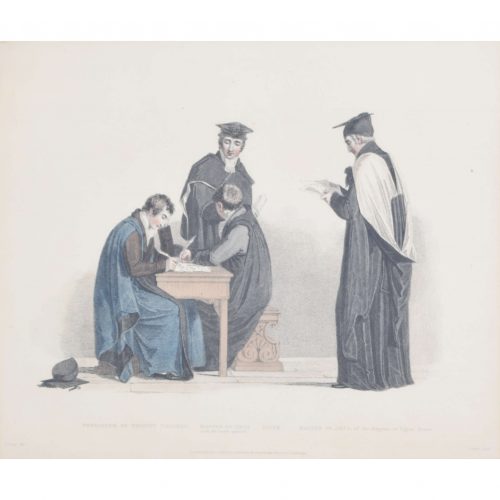
John Samuel Agar (1773 - 1858) after John Uwins (1782 - 1857)
Pensioner of Trinity College, Masters of Arts, and Sizer (1815)
Hand-coloured aquatint 25 x 30 cm Published by Rudolph Ackermann (1764 - 1834). An engraving of a pensioner of Trinity College, Masters of Arts, and a sizer (that is, an undergraduate who receives some form of assistance such as meals, lower fees or lodging during his or her period of study, in some cases in return for doing a defined job) from Ackermann's ''A History of the University of Cambridge, Its Colleges, Halls and Public Buildings''. The four figures walk forward with ceremonial accoutrements, likely to a graduation ceremony. At Cambridge, a sizar was originally an undergraduate student who financed his studies by undertaking more or less menial tasks within his college but, as time went on, was increasingly likely to receive small grants from the college. Certain colleges, including St John's and Trinity, distinguished between two categories of sizar: there were specific endowments for specific numbers of sizars who were called "proper sizars"; those who were not so endowed, but who were maintained by fellow-commoners and fellows were called subsizars. Isaac Newton matriculated as subsizar at Trinity College. Richard S. Westfall noted that sizars were considerably more successful in gaining degrees than the gentlemen who entered Cambridge in the seventeenth century. Thomas Uwins RA RWS was a British painter in watercolour and oil, and a book illustrator. He became a full member of the Old Watercolour Society and a Royal Academician, and held a number of high-profile art appointments including the librarian of the Royal Academy, Surveyor of Pictures to Queen Victoria and the Keeper of the National Gallery. In the late 1790s he began producing work for Ackermann''s collections. John Samuel Agar was an English portrait painter and engraver, who exhibited his works at the Royal Academy from 1796 to 1806 and at the British Institution until 1811. He was at one time president of the Society of Engravers. Rudolph Ackermann published many of his engravings. Rudolph Ackermann was an Anglo-German bookseller, inventor, lithographer, publisher and businessman. In 1795 he established a print-shop and drawing-school at 96 Strand. Here Ackermann set up a lithographic press and began a trade in prints. He later began to manufacture colours and thick carton paper for landscape and miniature painters. Within three years the premises had become too small and he moved to 101 Strand, in his own words "four doors nearer to Somerset House", the seat of the Royal Academy of Arts. Between 1797 and 1800 Ackermann rapidly developed his print and book publishing business, encompassing many different genres including topography, caricature, portraits, transparencies and decorative prints. Condition: good. Some age toning. If you’d like to know more, please email info@manningfineart.co.uk or call us on 07929 749056. -
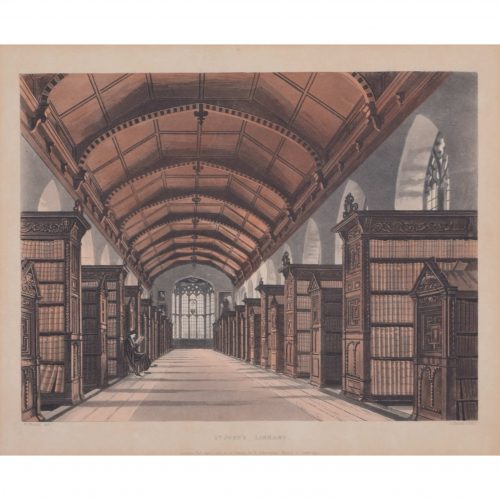
D Havell (1785 - 1822) after William Westall (1781 - 1850)
The Library of St John's College, Cambridge (1815)
Hand-coloured aquatint 24 x 29.5 cm Published by Rudolph Ackermann (1764 - 1834). An engraving of St John's College, Cambridge's marvellous library. It was built between 1623 and 1628, largely through the donations and efforts of two members of the college: Valentine Carey, Bishop of Exeter, and John Williams, Lord-Keeper and Bishop of Lincoln. The building's shell was completed in 1624, a date which appears on the south gable of the western oriel window. The building is constructed in the Jacobean Gothic style, and measures 110 feet by 30 feet wide. The tall two-light windows are a very early example of Gothic Revival, but the façade is Renaissance-inspired. The library contains 42 bookcases arranged at right angles to the north and south walls, and is the home of the College's double-manual harpsichord. William Westall was a British landscape artist. He was born in Hertford and enrolled at the Royal Academy schools in 1799. He later became the draughtsman for a voyage to Australia and the South Seas. After being shipwrecked, he travelled to Canton in China and to India, staying in Bombay for several months. He returned to England in 1805 but later set off for Madeira and Jamaica. He became a member of the Society of Painters in Water Colours (1811) and an associate of the Academy (1812). Following a mental breakdown, he regularly visited the Lake District and published ‘Views of the Valley and Vale of Keswick’ (1820). His series of aquatints of the Thames, the great universities, and England''s public schools for Ackermann are among his most popular works. The Havell family of Reading, Berkshire, England, included a number of notable engravers, etchers and painters, as well as writers, publishers, educators, and musicians. Daniel and Robert Havell set up in partnership as aquatint engravers. Soon Daniel began to work independently, engraving plates for Rudolph Ackermann''s History of Cambridge (1815) and hid history of various public schools including Eton, Winchester, and Rugby (1816), as well as a celebrated views of St Paul''s Cathedral (1818) and various other London landmarks for Ackermann''s Repository of Arts. Rudolph Ackermann was an Anglo-German bookseller, inventor, lithographer, publisher and businessman. In 1795 he established a print-shop and drawing-school at 96 Strand. Here Ackermann set up a lithographic press and began a trade in prints. He later began to manufacture colours and thick carton paper for landscape and miniature painters. Within three years the premises had become too small and he moved to 101 Strand, in his own words "four doors nearer to Somerset House", the seat of the Royal Academy of Arts. Between 1797 and 1800 Ackermann rapidly developed his print and book publishing business, encompassing many different genres including topography, caricature, portraits, transparencies and decorative prints. Condition: good. Some age toning. If you’d like to know more, please email info@manningfineart.co.uk or call us on 07929 749056. -
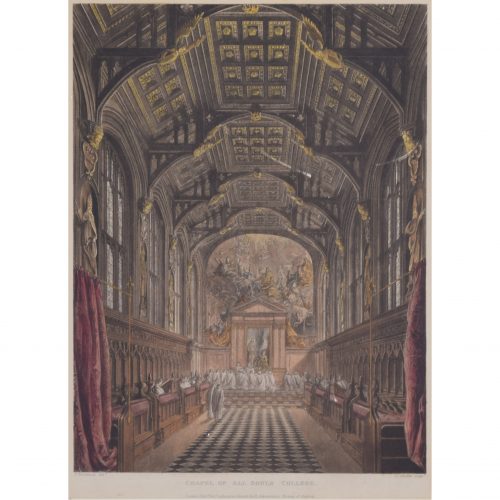
Joseph Constantine Stadler (1755 - 1828) after Frederick Mackenzie (1788 - 1854)
The Chapel of All Souls College, Oxford (1814)
Hand-coloured aquatint 29.5 x 21 cm Published by Rudolph Ackermann (1764 – 1834). An engraving of All Souls' chapel. All Souls College was founded in 1437 by Henry Chichele, Archbishop of Canterbury, to serve as a memorial to Henry V and the English dead in the Hundred Years War. The Front Quad appears virtually unchanged since it was first built in the years 1438-1343, thanks to a sympathetic Victorian restoration. The chapel was modelled after that of New College, where Chichele was a Member. It has a superb hammer-beam roof, excellent mediaeval stained glass, and a large number of original stalls. All services in the chapel are according to the Book of Common Prayer; the King James Bible is also used rather than more modern translations. Frederick Mackenzie (circa 1788 - 1854) was a British watercolourist and architectural draughtsman. He first exhibited at the Royal Academy in 1804, and contributed eleven drawings between that year and 1828. He contributed to the Society of Painters in Water Colours exhibitions from 1813, becoming an associate in 1822, and a full member the following year. From 30 November 1831 until, his death he was treasurer to the society. In later life Mackenzie was no longer commissioned to illustrate books. Joseph Constantine Stadler was a prolific German émigré engraver of images after his contemporaries - here, 18th-century English landscape painter and diarist Joseph Farington. Stadler''s engravings are wide-ranging in subject matter and include landscapes, seascapes and portraits, as well as military, sporting and decorative subjects. Stadler was employed by the leading print publisher of the time, John Boydell. Stadler lived in Knightsbridge when he died at the age of 73. Rudolph Ackermann was an Anglo-German bookseller, inventor, lithographer, publisher and businessman. In 1795 he established a print-shop and drawing-school at 96 Strand. Here Ackermann set up a lithographic press and began a trade in prints. He later began to manufacture colours and thick carton paper for landscape and miniature painters. Within three years the premises had become too small and he moved to 101 Strand, in his own words "four doors nearer to Somerset House", the seat of the Royal Academy of Arts. Between 1797 and 1800 Ackermann rapidly developed his print and book publishing business, encompassing many different genres including topography, caricature, portraits, transparencies and decorative prints. Condition: good. Some age toning. If you’d like to know more, please email info@manningfineart.co.uk or call us on 07929 749056. -
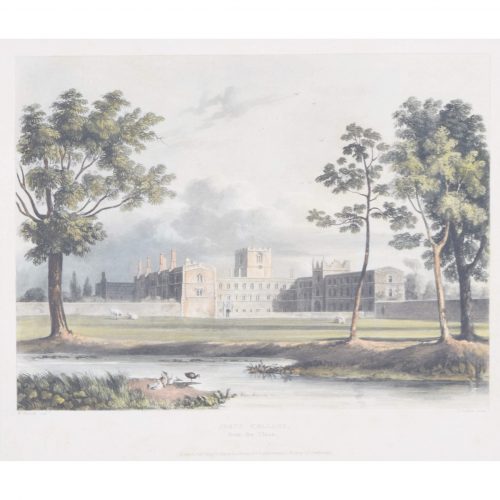
Joseph Constantine Stadler (1755 - 1828) after William Westall (1781 - 1850)
Jesus College, Cambridge, from the Close (1815)
Hand-coloured aquatint 24 x 29.5 cm Published by Rudolph Ackermann (1764 - 1834). An engraving of Jesus College, foregrounded by trees, the River Cam, and grazing cattle. Joseph Constantine Stadler was a prolific German émigré engraver of images after his contemporaries - here, 18th-century English landscape painter and diarist Joseph Farington. Stadler''s engravings are wide-ranging in subject matter and include landscapes, seascapes and portraits, as well as military, sporting and decorative subjects. Stadler was employed by the leading print publisher of the time, John Boydell. Stadler lived in Knightsbridge when he died at the age of 73. William Westall was a British landscape artist. He was born in Hertford and enrolled at the Royal Academy schools in 1799. He later became the draughtsman for a voyage to Australia and the South Seas. After being shipwrecked, he travelled to Canton in China and to India, staying in Bombay for several months. He returned to England in 1805 but later set off for Madeira and Jamaica. He became a member of the Society of Painters in Water Colours (1811) and an associate of the Academy (1812). Following a mental breakdown, he regularly visited the Lake District and published ‘Views of the Valley and Vale of Keswick’ (1820). His series of aquatints of the Thames, the great universities, and England's public schools for Ackermann are among his most popular works. Rudolph Ackermann was an Anglo-German bookseller, inventor, lithographer, publisher and businessman. In 1795 he established a print-shop and drawing-school at 96 Strand. Here Ackermann set up a lithographic press and began a trade in prints. He later began to manufacture colours and thick carton paper for landscape and miniature painters. Within three years the premises had become too small and he moved to 101 Strand, in his own words "four doors nearer to Somerset House", the seat of the Royal Academy of Arts. Between 1797 and 1800 Ackermann rapidly developed his print and book publishing business, encompassing many different genres including topography, caricature, portraits, transparencies and decorative prints. Condition: good. Some age toning. If you’d like to know more, please email info@manningfineart.co.uk or call us on 07929 749056. -
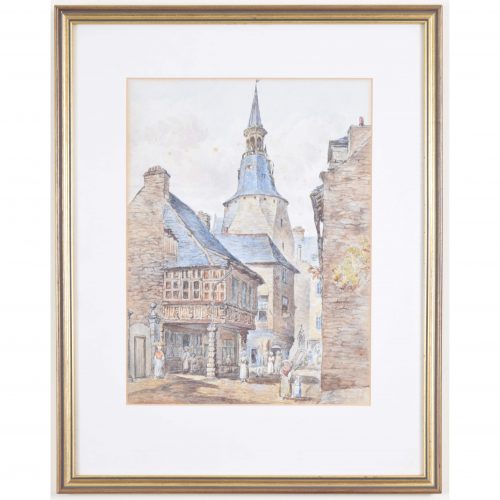
Attributed to Antony Vandyke Copley Fielding (1787 - 1855)
Dinan Tour de l’Horloge (Dinan Clock Tower)
Watercolour 28 x 21 cm A spirited watercolour of Dinan, Brittany. Dinan's famous clock tower looks over a French street scene: men, women, and children weave through the town's half-timbered houses, shops, and ateliers. The characterful mediaeval stonework and architecture of the town are paramount, and the artist adds a bright blue hue to his depiction of Dinan's roofs. Dinan is a walled medieval Breton town and commune in the Côtes-d'Armor department of northwestern France. Enclosed by nearly three kilometres of ramparts, the town and its 14th-century castle proudly overlook the Rance river. Anthony Vandyke Copley Fielding, commonly called Copley Fielding, was an English painter famous for his watercolour landscapes. At an early age Fielding became a pupil of John Varley. In 1810 he became an associate exhibitor in the Old Watercolour Society (later known as the Royal Society of Watercolours), in 1813 a full member, and in 1831 the Society's President. In 1824 he won a gold medal at the Paris Salon, alongside Richard Parkes Bonington and John Constable. Examples of his work are held by the Victoria and Albert Museum and other major museums in Britain. Condition: good. Some spotting to sky; handsomely framed. If you’d like to know more, please email info@manningfineart.co.uk or call us on 07929 749056. -
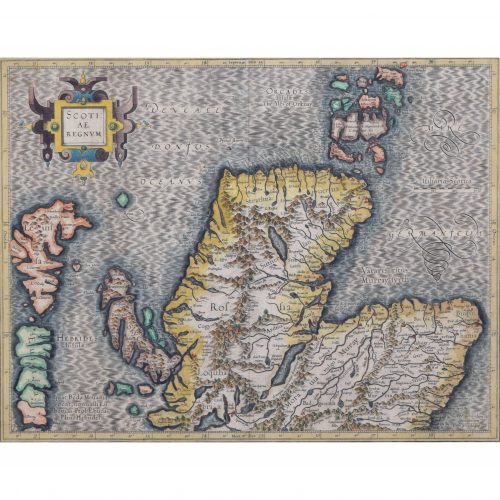
Gerardus Mercator (1512 - 1594)
Map of the North of Scotland (1683)
Engraving with later hand colouring 35 x 45 cm A fantastically characterful and detailed map engraving of the North of Scotland from 1683. The highly detailed and beautifully coloured map is inscribed to the reverse with a description of the parts of Scotland illustrated, called the ''Troisieme Table d''Escosse''. The map comes from the 1683 French edition of Gerardus Mercator''s Atlas Major, which was first published in 1585. Gerardus Mercator was the Flemish father of mapmaking. He was a skilled geographer, cosmographer and cartographer and is most renowned for creating the 1569 world map based on a new projection which represented sailing courses of constant bearing (rhumb lines) as straight lines - an innovation that is still employed in today''s nautical charts. Mercator was a highly influential pioneer in the history of cartography and is generally considered one of the founders of the Netherlandish school of cartography and geography. He is also widely considered the most notable figure of the school. In his own day, he was a notable maker of globes and scientific instruments. In addition, he had interests in theology, philosophy, history, mathematics and geomagnetism. He was also an accomplished engraver and calligrapher. Unlike other great scholars of the age, he travelled little and his knowledge of geography came from his library of over a thousand books and maps, from his visitors and from his vast correspondence (in six languages) with other scholars, statesmen, travellers, merchants and seamen. Mercator''s early maps were in large formats suitable for wall mounting but in the second half of his life, he produced over 100 new regional maps in a smaller format suitable for binding into his Atlas of 1595. This was the first appearance of the word Atlas in reference to a book of maps. However, Mercator used it as a neologism for a treatise (Cosmologia) on the creation, history and description of the universe, not simply a collection of maps. He chose the word as a commemoration of the Titan Atlas, "King of Mauretania", whom he considered to be the first great geographer. Mercator wrote on geography, philosophy, chronology and theology. All of the wall maps were engraved with copious text on the region concerned. As an example, the famous world map of 1569 is inscribed with over five thousand words in fifteen legends. Condition: a little spotting, primarily to margins. If you’d like to know more, please email info@manningfineart.co.uk or call us on 07929 749056. -
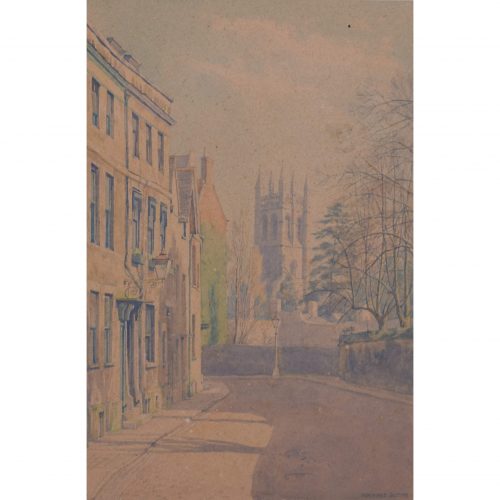
Bernard Cecil Gotch (1876 - 1964)
Merton Street, Oxford
Watercolour 37 x 25.5 cm Signed in pencil lower right. A wintry view of Holywell Street, Oxford, where Charles Ryder and Sebastian Flyte famously take up lodgings in Brideshead Revisited. Magdalen Tower peeps out over the cobbled lane. On the other side of the wall is the Fellows Garden of Merton College. Bernard Cecil Gotch was a Winchester-born artist who is best known for his atmospheric watercolours of Britain's towns and cities (most notably Oxford). He moved to Oxford in 1927, painting many watercolours of the interiors and exteriors of Oxford’s many buildings. His works concentrate on the grand exteriors and interiors of the University's colleges, and he exhibited frequently - including an exhibition every term at Oriel College. His first notable commission was for the publisher Methuen, illustrating ''A Shepherd’s Life'' by W H Hudson. Whilst in London he was invited to illustrate a book on the Public Schools of England (which was sadly never completed). He exhibited watercolours at the Fine Art Society and Lincolns Inn, and also exhibited at the Royal Academy. In 1952 Gotch was given an Honorary MA by the University of Oxford, and, after his death in 1963, a memorial was held for him at Oriel. Condition: slight discolouration to paper. If you’d like to know more, please email info@manningfineart.co.uk or call us on 07929 749056. -
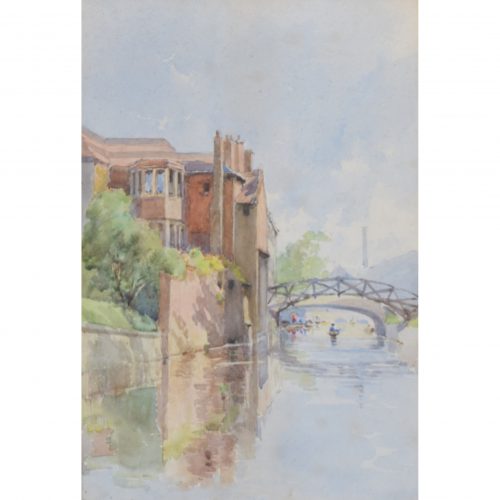
The Mathematical Bridge, Queens' College, Cambridge
Watercolour 27 x 18 cm A delightful watercolour of Cambridge's famous Mathematical Bridge. Figures punt under the bridge and the buildings of Queens are reflected in the serene waters of the River Cam. Kate Hillman of the Cambridge University Engineering Department notes that: "One of the most recognisable structures on the Cam, Queens' College bridge was originally built in 1749 by James Essex the Younger. Since then it has been rebuilt twice to the original design of William Etheridge, once in 1866 and again in 1905. In 1866 the bridge deck was changed from a stepped design to the current sloped deck. In 1905 a complete rebuild of the bridge was required due to weathering of the original oak structure. stories have suggested that a group of students (or professors, depending on the storyteller) disassembled the bridge to discover how it stood up and then couldn't put it back together. The bridge was supposedly then rebuilt using rather prominent bolts." Condition: very good; gilt frame has some age. If you’d like to know more, please email info@manningfineart.co.uk or call us on 07929 749056. -
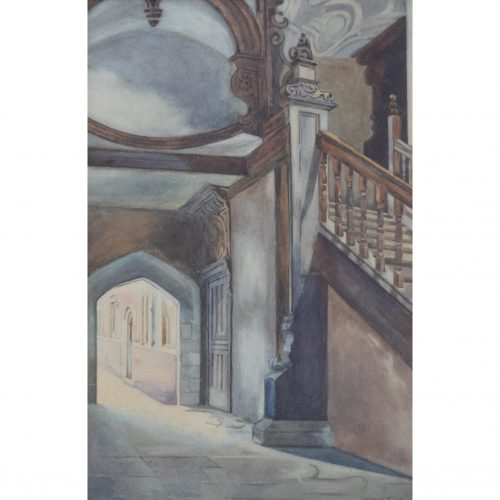
After Ernest William Haslehurst (1866 - 1949)
E Staircase, Second Court, St John's College, Cambridge (circa 1915)
Watercolour 33 x 22 cm Haslehurst's watercolour of a staircase at John's. The artists captures the quintessential Cambridge combination of dark wood and old stone, focusing on a beautiful but overlooked passageway in the college. Light streams in from the court. Second Court was built in the years immediately after 1599, to the designs of Ralph Symons of Westminster and Gilbert Wigg of Cambridge. The harmonious proportions and local brickwork of the Court in general make it the finest example of this style of architecture in Cambridge. Ernest William Haslehust was an English landscape painter and book illustrator who worked in watercolours. He was a member of the Royal Institute of Painters in Water Colours (RI), Royal Society of British Artists (RBA), Royal West of England Academy (RWA) and Royal British Colonial Society of Artists (RBC), and exhibited regularly at many venues including the Royal Academy in London. He also designed posters for the LNER and LMS railway companies, and his art was featured in many magazines of the day including the Illustrated London News and The Tatler. His painting of this view was featured in the illustrated book of Cambridge by Noel Barwell (Blackie & Son) 1910, and the artist of this painting has recorded the view from the same corner. Condition: very good; some light spotting. Handsome antique frame which bears some signs of age. If you’d like to know more, please email info@manningfineart.co.uk or call us on 07929 749056. -
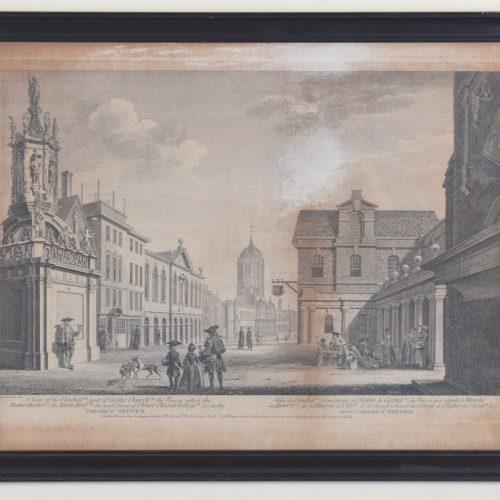
John Donowell (flourished 1753 - 1786) A View of the Conduit part of Carfax Church, the Piazza called the Butter Market, the Town Hall, the West Front of Christ Church College, &c. in the University of Oxford (1750)
Engraving 29 x 42 cm An eighteenth century view of St Aldate''s, featuring the west front of Christ Church and the Town Hall. Undergraduates, academics, and townspeople saunter along, all under the watchful eye of Tom Tower. John Donowell was an eighteenth-century British architect and engraver, considered to be one of the principal architect-draughtsmen in the latter part of the eighteenth century. He exhibited in 1761 at the Free Society, then through the 1760s at the Society of Artists, and from 1778 to 1786 at the Royal Academy; prints, some hand-coloured, were published at this time. Condition: some browning; antique frame with old glass. If you’d like to know more, please email info@manningfineart.co.uk or call us on 07929 749056. -
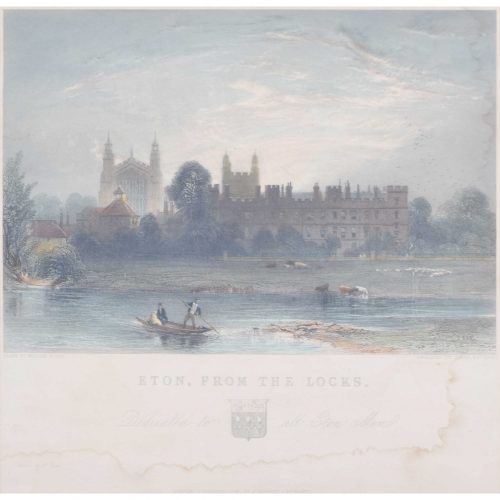
James Redaway (1797 - 1858)
Eton from the Locks
Hand-coloured engraving 27 x 28 cm Redaway's view of Eton College, seen from the locks on the River Thames. James Redaway was a nineteenth-century engraver, principally of landscapes and architectural subjects. Condition: some staining to lower half of print. If you’d like to know more, please email info@manningfineart.co.uk or call us on 07929 749056. -
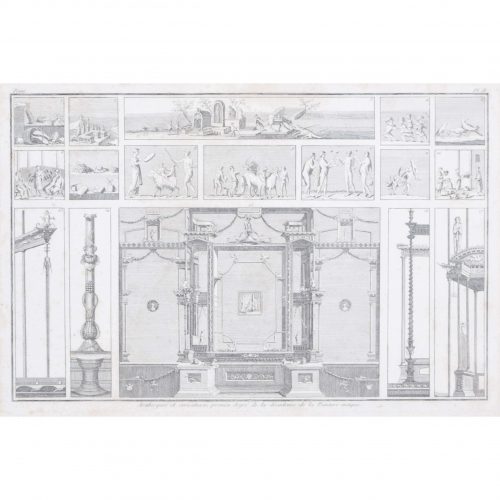
Arabesques and caricatures
Engraving 24.5 x 36 cm Condition: good. If you’d like to know more, please email info@manningfineart.co.uk or call us on 07929 749056. -
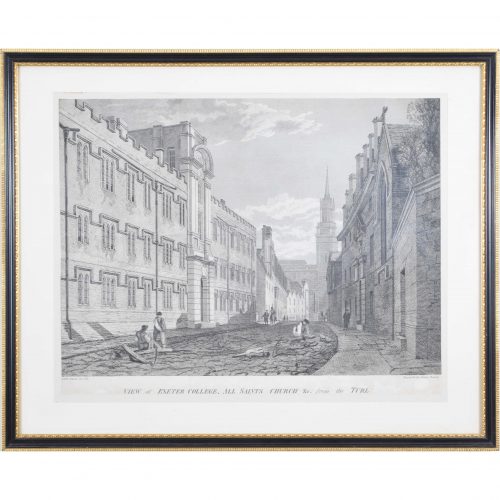
James Basire II (1769 - 1822) after JMW Turner (1775 - 1851)
View of Exeter College, All Saints Church &c. from the Turl
Engraving 35 x 46 cm A view of Exeter College, Oxford from Turl Street. Labourers cobble the road. The spire of what was All Saints Church, now Lincoln College's library, overlooks the scene. Turner's drawing was reproduced as a lithograph in 1800, to be published in the “Oxford Almanack”. The Oxford Almanack was an annual almanack published by the Oxford University Press for the University of Oxford from 1674 through 2019 (when printing sadly ceased due to “dwindling interest”). The almanack traditionally included engravings or lithographs of the University and information about the upcoming year. Other almanack artists have included Michael Burghers and John Piper. Basire and Dayes collaborated on several views of Oxford during the courses of their careers. Joseph Mallord William Turner RA, known in his time as William Turner, was an English Romantic painter, printmaker and watercolourist. He is known for his expressive colouring, imaginative landscapes and turbulent, often violent, marine paintings. He left behind more than 550 oil paintings, 2,000 watercolours, and 30,000 works on paper. He was championed by the leading English art critic John Ruskin from 1840, and is today regarded as having elevated landscape painting to an eminence rivalling history painting. James Basire II was a British engraver, son of James Basire I, also a celebrated engraver. In 1802 he became Engraver to the Society of Antiquaries. Condition: trimmed within plate mark and mounted to paper. If you’d like to know more, please email info@manningfineart.co.uk or call us on 07929 749056. Other views of Exeter College, Oxford are available here. -
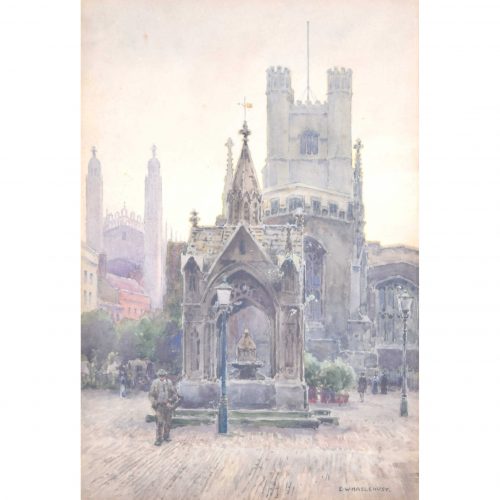
Ernest William Haslehurst (1866 - 1949)
The Market Place, Cambridge, with a view of Great St Mary’s Church and King's College Chapel
Watercolour 33.5 x 23 cm Haslehurst's watercolour of Cambridge's marketplace, overlooked by the spires of King's College Chapel and Great St Mary's. Ernest William Haslehust was an English landscape painter and book illustrator who worked in watercolours. He was a member of the Royal Institute of Painters in Water Colours (RI), Royal Society of British Artists (RBA), Royal West of England Academy (RWA) and Royal British Colonial Society of Artists (RBC), and exhibited regularly at many venues including the Royal Academy in London. He also designed posters for the LNER and LMS railway companies, and his art was featured in many magazines of the day including the Illustrated London News and The Tatler. Condition: generally good. Some spotting. If you’d like to know more, please email info@manningfineart.co.uk or call us on 07929 749056. -
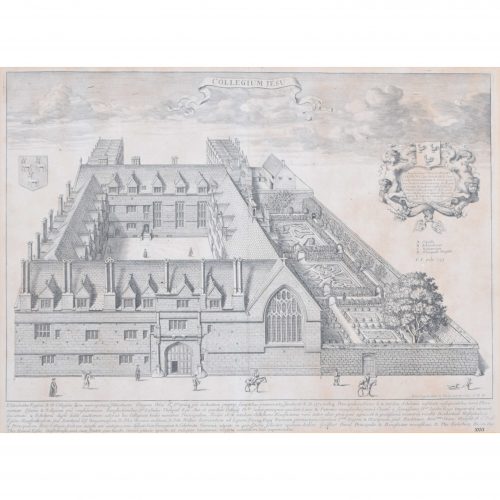
David Loggan (1634 - 1692)
Jesus College, Oxford (1705)
Engraving 29 x 41 cm Loggan was born to English and Scottish parents, and was baptised in Danzig in 1634. After studying engraving in Danzig with Willem Hondius (1598 - 1652 or 1658), he moved to London in the late 1650s, going on to produce the engraved title-page for the folio 1662 Book of Common Prayer. He married in 1663 and moved to Nuffield in Oxfordshire in 1665. Loggan was appointed Public Sculptor to the nearby University of Oxford in the late 1660s, having been commissioned to produce bird’s-eye views of all the Oxford colleges. He lived in Holywell Street as he did this. The 'Oxonia Illustrata' was published in 1675, with the help of Robert White (1645 - 1704). Following its completion, Loggan began work on his equivalent work for Cambridge; the 'Cantabrigia Illustrata' was finally published in 1690, when he was made engraver to Cambridge University. The "Oxonia Illustrata" also includes an engraving of Winchester College (Winchester and New College share William of Wykeham as their founder) whilst the "Cantabrigia Illustrata" includes one of Eton College (which shares its founder, Henry VIII, with King’s College). Bird’s-eye views from this era required a particular talent as an architectural perspectivist; it was not until 1783 that it became possible for artists to ascend via hot air balloons and view the scenes they were depicting from above. Loggan thus had to rely on his imagination in conceiving the views. Loggan’s views constitute the first accurate depictions of the two Universities, in many ways unchanged today. Whilst the Oxford engravings were produced in reasonable numbers and ran to a second edition by Henry Overton (on thicker paper and with a plate number in Roman numerals in the bottom right-hand corner), those of Cambridge were printed in much smaller numbers. The Dutchman Pieter van der Aa published some miniature versions of the engravings for James Beverell’s guidebook to the UK, ''Les Delices de la Grande Bretagne'' (circa 1708). The contemporary artist Andrew Ingamells has produced a highly-acclaimed series of etchings which bring Loggan’s original vision up to date. Condition: generally very good. Slight time staining. If you’d like to know more, please email info@manningfineart.co.uk or call us on 07929 749056. -
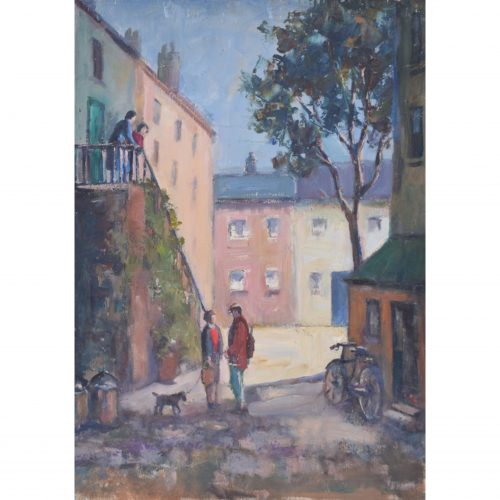
Angela Stones (1914 - 1995)
French Street Scene
Oil on board 56 x 41 cm A delightful mid-century oil painting. A couple and their dog meander down a cobbled French lane under a bright blue sky. Stones was educated at the Chelsea School of Art, and was a member of an artistic dynasty. Her mother Dorothy Bradshaw (1893-1983) studied under Jack Merriott – the artist famous for his British Rail posters, and her son, Christopher Assheton-Stones (1947-1999), was arguably the foremost pastel artist of his time. Provenance: the family of the artist. Condition: very good. If you’d like to know more, please email info@manningfineart.co.uk or call us on 07929 749056. -
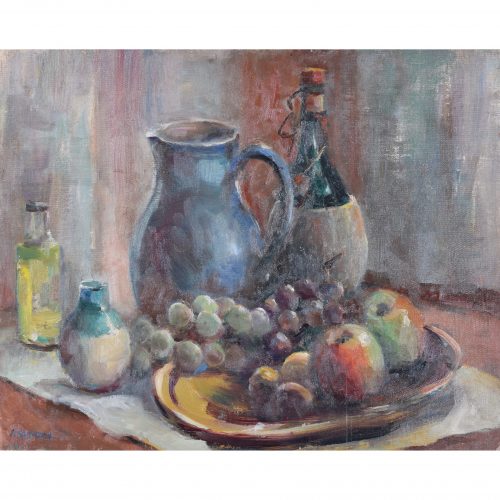
Angela Stones (1914 - 1995)
Still Life with Fruit and Jug
Oil on board 40 x 50 cm Signed lower left. A stylish mid-century still life, characterised by Stones' lively brushwork and rich use of colour. Stones was educated at the Chelsea School of Art, and was a member of an artistic dynasty. Her mother Dorothy Bradshaw (1893-1983) studied under Jack Merriott – the artist famous for his British Rail posters, and her son, Christopher Assheton-Stones (1947-1999), was arguably the foremost pastel artist of his time. Provenance: the family of the artist. Condition: very good. If you’d like to know more, please email info@manningfineart.co.uk or call us on 07929 749056. -
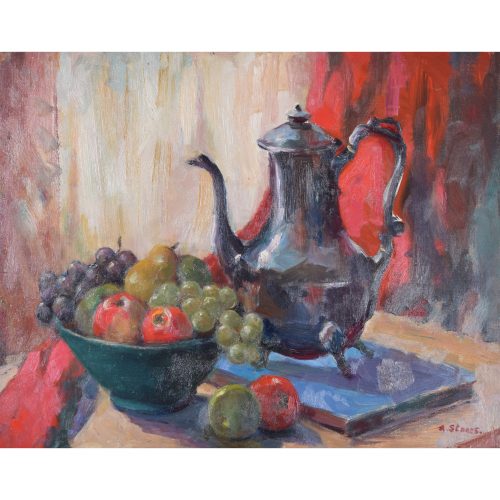
Angela Stones (1914 - 1995)
Still Life with Fruit and Coffee Pot
Oil on board 41 x 51 cm Signed lower right. A sophisticated mid-century still life, characterised by gleaming coffee pot and brimming fruit bowl. The rich red of the apples communicates with the scarlet of the draperies and Stones' signature, just as the bluish-purple hues of the grapes do with the glinting metal of the coffee pot and the blue book on which it stands. Stones was educated at the Chelsea School of Art, and was a member of an artistic dynasty. Her mother Dorothy Bradshaw (1893-1983) studied under Jack Merriott – the artist famous for his British Rail posters, and her son, Christopher Assheton-Stones (1947-1999), was arguably the foremost pastel artist of his time. Provenance: the family of the artist. Condition: very good. If you’d like to know more, please email info@manningfineart.co.uk or call us on 07929 749056.

